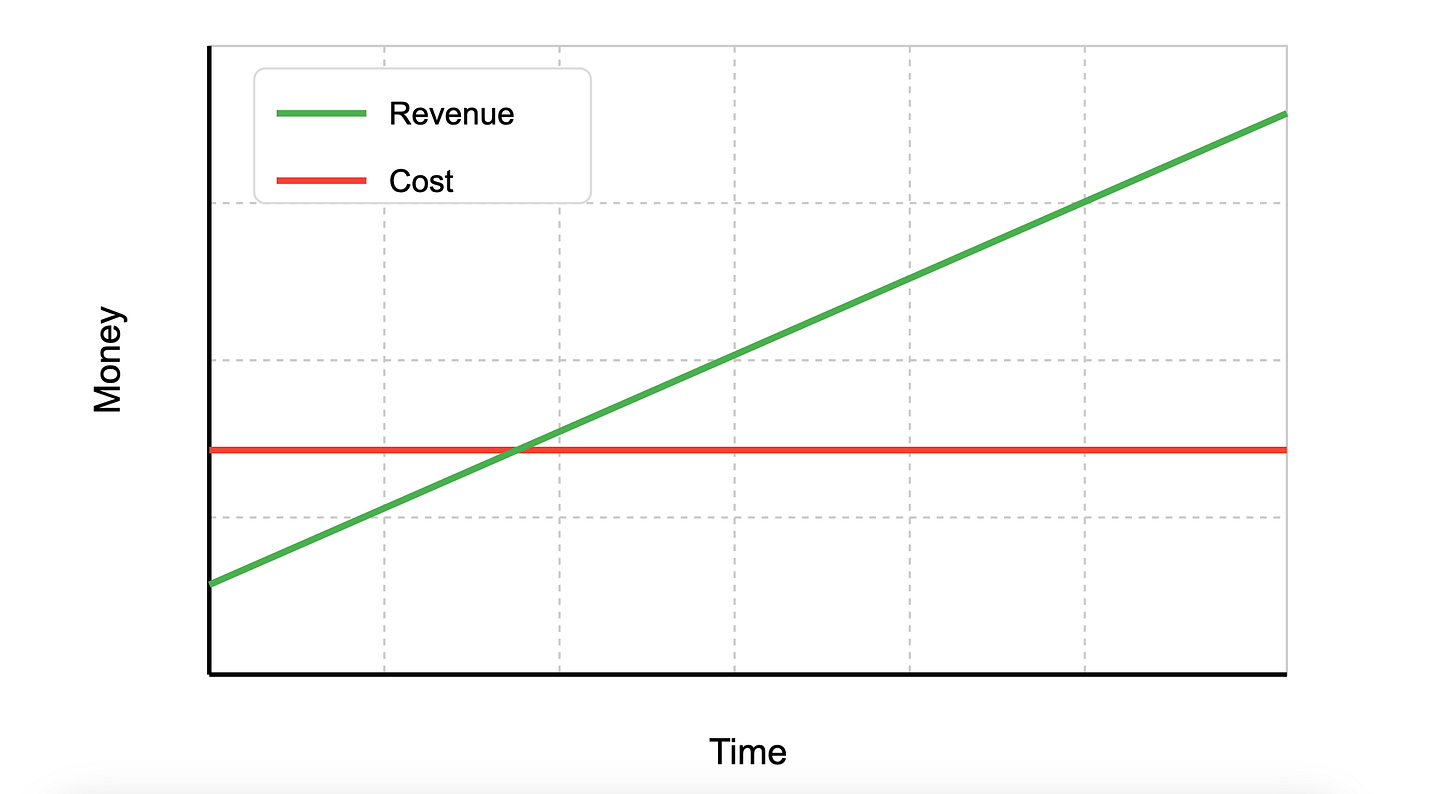Software is a form of leverage
And why AI seems to have conjured a collective stroke in the industry
Since I started working in tech four years ago, I’ve experienced four layoffs. One which affected me, and three others where I was spared but in which I saw close friends and colleagues go.
Never in my measly undergraduate imagination, when I first decided to learn how to build software, did I imagine that such lousy economic circumstances could pervade for so long. I believed software to be an invincible industry of the future, ripe for stable employment and mild contentment. (I was too young for the dotcom bubble to have made an impression, it seems 😅)
Meanwhile, all these companies shedding employees seem only to be growing in market valuation. And people in tech continue to make good money relative to the general population. It’s a bizarre combination of lopsided growth and simultaneous contraction, a collection of spasms reminiscent of the iconic transformation scene in An American Werewolf in London.
I realize that’s a pretty dark metaphor, but it was the first to come to mind.
The lazy answer for all these layoffs you’ll find on Reddit and social media is corporate greed. And AI. It’s not necessarily the wrong answer, but its horribly imprecise to the point of being meaningless.
It wasn’t until recently that I was able to pull together a few major converging factors into a coherent narrative, one that I think adequately represents where we are.
Why it’s helpful to think of software as leverage
Software can be immensely lucrative because, at it’s core, it’s leveraged.
You can solve a problem once, and assuming you solved it well, replicate it millions of times with minimal added cost.
This isn’t the case when you produce t-shirts or the latest bro-supplement. In those traditional industries, every unit you sell must be physically produced, and therefore your margins are much lower compared to software.
But to unlock that upside potential, you need to solve a common business problem comprehensively, and ship that solution to thousands if not millions of users. That scale is a challenging problem. To solve it, you need smart people with relatively rare skill sets. That makes them expensive, even more so when your competitors are trying to tap them as well.
So software is effectively a business where you front load your costs with the hopes of getting a lot of run away potential. This is what makes venture capital and startups work the way they do and why the industry is so often speculative to the point of being absurd. It pays to shoot for the moon.
A perfect storm gathers
1. Everyone is Leveraged (2020-2022)
The previous decade established and matured a lot of software business models, Software as a Serivce (SaaS), ecommerce (Amazon), marketplaces (Etsy, Uber), and streaming (Netflix).
When COVID first hit, the world fell back on these systems as traditional, in-person alternatives collapsed.
As a result, everyone in the industry loaded up on their chips given how well things were going. Hiring demand was sky-high, employee compensation hit records.
2. Zero Interest Policy Ends (March 2022)
ZIRP stands for zero interest-rate policy, which effectively makes borrowing money cheap. The end of ZIRP increased the cost of borrowing, so all these expensive, employee-heavy bets also grew in cost.
We saw some minor rumbles in the tech sector as some investments were pulled back as a result.
3. GPT from OpenAI comes online (November 2022)
LLMs (large language models like GPT), as implemented and designed by OpenAI, signified a paradigm shift. They introduced new ways to solve hard problems and easier ways to solve simpler ones. Companies like Chegg and Grammarly immediately felt the pain.
Obviously LLMs are not a panacea, but they do trivialize a substantial portion of machine learning problems.
The industry woke up to the idea that pursuing AI-solutions in the vein of LLMs is where the major developments of the next decade will occur.
In turn, everyone realizes that they’re leveraged in the wrong direction.
And their leverage is getting more expensive as interest rates goes up. And they’ve over-hired people at premium rates. And these people, they believe, have the wrong skill sets for the future.
queue massive indiscriminate layoffs
The fallout

The tech industry’s exposure to LLMs has only grown since 2022. And everyone is confused. Including me at times.
Most of these AI tools are 💩. Others are genuinely helpful and vast improvements over their predecessors, especially if you invest to learn how to use them.
Things will continue sorting themselves out as best practices, patterns, and further developments emerge.
In the meantime, the disruptions will continue. Tech workers, as I mentioned, are expensive to their employers. Counterintuitively, this makes their work especially vulnerable to AI.
If a service manages to successfully augment or replace some of the work of a software engineer, for example, that means they’ve solved a problem that the business has been willing to pay lot of money to solve in the first place. That means the service can charge a lot of money too. The incentives are there to go after high-paying white collar jobs.
Even if the tools can’t fully replace an engineer, any AI tools that amplify a senior employee's output will be adopted too. They allow a company to better stretch their best resources. These solutions don't even need to be better than a human—they just need to approximate the work well enough.
If you subscribe even a little bit to the Bullshit Jobs argument of the late David Graeber,1 where he argues a significant portion of white collar jobs are meaningless with little real valuable output, it’s not hard to imagine those jobs going away even when the tools themselves don’t blow your mind.
There's a cannibalistic aspect to software that Paul Krugman once captured (albeit incorrectly) when he predicted in 1998 that the internet would produce less economic value than the fax machine. While he was profoundly wrong about the numbers, he pointed at something important: much of the Internet's growth came from gobbling up existing businesses: newspapers, retailers, and movie theaters.
We’re entering into an era where a lot of major software incumbents are especially vulnerable to a similar fate. They have complex legacy solutions that, if approached correctly, could be built better and cheaper with the use of LLMs. This future has been referred to as “product-market fit collapse,” where many businesses will struggle to catch up to competitors who effectively leverage what’s available in our new world.2
In the future, I’ll likely try to shed some more optimistic light on these technological developments. But in the interim, it’s difficult to see the spasms of transformation subsiding any time soon.
https://en.wikipedia.org/wiki/Bullshit_Jobs
This tension has been illustrated perfectly in this article by Reforge.



